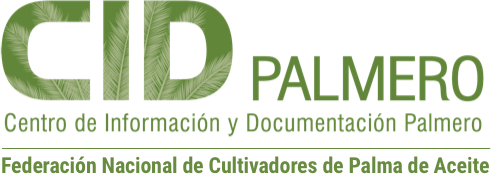| dc.creator | Franco Valbuena, Luz A. | |
| dc.creator | Delgado, Tulia E. | |
| dc.creator | Rincón Numpaque, Álvaro | |
| dc.creator | Molina López, Diego Luis | |
| dc.creator | Beltrán Giraldo, Jorge Alonso | |
| dc.creator | Mosquera Montoya, Mauricio | |
| dc.date | 2018-12-31 | |
| dc.date.accessioned | 2020-07-25T11:21:43Z | |
| dc.date.available | 2020-07-25T11:21:43Z | |
| dc.identifier | https://publicaciones.fedepalma.org/index.php/palmas/article/view/12708 | |
| dc.identifier.uri | http://repositorio.fedepalma.org/handle/123456789/140808 | |
| dc.description | Se estimó que para 2016 en Colombia había 64.418 hectáreas sembradas con cruzamientos OxG, cifra que corresponde a 13,3 % del área total cultivada con palma aceitera en el país para ese mismo año. Algunos de estos cultivares han probado ser resistentes a la Pudrición del cogollo, por lo que se han convertido en una alternativa para resembrar áreas afectadas por esta enfermedad. A pesar de que muchos cultivadores consideran sembrar cruzamientos OxG, debe decirse que existen vacíos en lo que concierne a su manejo nutricional. Con el fin de arrojar luz acerca de su manejo nutricional, en 2011 Cenipalma, en convenio con el Instituto Internacional para la Nutrición de Plantas (IPNI, por sus siglas en inglés), inició trabajos orientados a determinar los requerimientos nutricionales en la fase de vivero de estos cruzamientos. Los resultados de dicho trabajo indicaron que las plántulas de vivero requieren N (30 g), P (10 g), K (10 g) y B (0,5 g). Estos resultados fueron validados en un vivero de la Zona Norte, en el cual se seleccionaron 450 palmas como objeto de estudio. Las palmas se separaron en dos grupos: el primero recibió la dosis de nutrientes que resultó de la investigación de Cenipalma y el ipni, mientras que el segundo recibió la dosis que las plantaciones suelen utilizar en sus viveros. Durante diez meses se monitorearon las variables de crecimiento vegetativo, contenido de materia seca y contenido nutricional en cuatro tejidos (raíz, bulbo, raquis y foliolos). Se utilizaron pruebas de diferencia de medias para hacer comparaciones estadísticas de las variables de crecimiento vegetativo y de materia seca. Con respecto al contenido de nutrientes, las muestras fueron enviadas al Laboratorio de Análisis Foliares y de Suelos de Cenipalma, tras lo cual se pudo determinar que no hubo diferencias significativas en las variables de interés. Sin embargo, los análisis de contenido de nutrientes indicaron una mejor absorción de nutrientes en las palmas tratadas con las dosis sugeridas por Cenipalma y el ipni. Adicionalmente, se llevó a cabo un análisis de costos que permitió identificar un ahorro al utilizar la dosis sugerida por Cenipalma y el ipni. Dicho ahorro obedece a un menor gasto en fertilizantes como resultado de una reducción de 27 % en el uso de este tipo de productos. Por último, se determinó que el ahorro total de la fase de vivero es de 7 % cuando se utiliza la dosis sugerida por Cenipalma y el IPNI, hecho que resultan de interés para las empresas que desarrollan y venden plántulas. | es-ES |
| dc.description | According to estimates, in 2016 Colombia had 64,418 hectares planted with OxG oil palm crossings, which accounted for 13.3% of the total area planted with oil palm trees in the country. Some of these crossings have proven to be resistant to bud rot, thus becoming an alternative to replant oil palm plantations in areas affected by this disease. Even though many oil palm growers are considering OxG crossings for cultivation, there is a lack of knowledge on their nutritional requirements that needs to be addressed. With the aim of shedding some light on the nutritional requirements of OxG crossings, in 2011 Cenipalma and the International Plant Nutrition Institute (IPNI) started doing research on the requirements of these crossings at nursery stage. Their results indicated that nursery palms require N (30g), P (10 g), K (10g) and, B (0.5 g). These results were validated in an oil palm nursery at the Colombian Northern Zone, where 450 Coarí x La Mé plantlets were selected for research purposes. These palms were separated into two groups: the first group was given the nutritional doses resulting from the research by Cenipalma and ipni; while the second received the doses usually applied by growers at their plantations. Palms from both groups were monitored during ten months to observe their vegetative growth, dry matter, and nutrient content at four tissues (roots, bulb, rachis and leaflet). Statistical comparisons for vegetative growth and dry matter were carried out using mean difference tests. Regarding nutritional content, samples were studied at Cenipalma’s Foliar and Soil Analyses Lab, where results showed no statistical differences on the means of the variables of interests; although greater absorption of nutrients was observed in plantlets treated with the doses suggested by Cenipalma and ipni. In addition, costs estimations analyses allowed determining savings when using the doses suggested by Cenipalma and IPNI, which came from a lower expense on fertilizers as a result of a 27% reduction in the use of these products. Finally, a 7% economic saving during the whole nursery stage was estimated when the doses recommended by Cenipalma and ipni are used. This result is of great interest for companies dedicated to grow and sell plantlets. | en-US |
| dc.format | application/pdf | |
| dc.language | spa | |
| dc.publisher | Fedepalma | es-ES |
| dc.relation | https://publicaciones.fedepalma.org/index.php/palmas/article/view/12708/12612 | |
| dc.source | Revista Palmas; Vol. 39 Núm. 4 (2018); 13-23 | es-ES |
| dc.source | 0121-2923 | |
| dc.title | Requerimiento nutricional del híbrido interespecífico OxG en fase de vivero | es-ES |
| dc.title | Nutritional Requirement of Interspecific OxG Hybrid Plants during Nursery Stage | en-US |
| dc.type | info:eu-repo/semantics/article | |
| dc.type | info:eu-repo/semantics/publishedVersion | |


